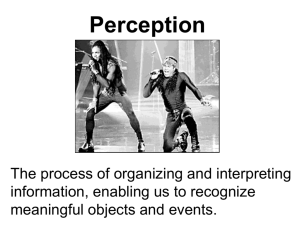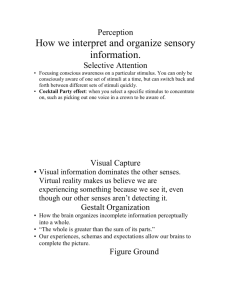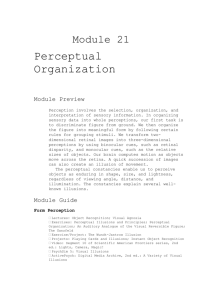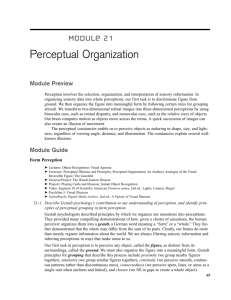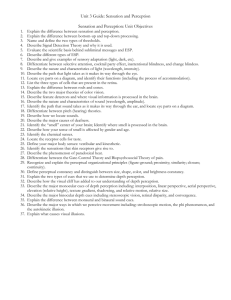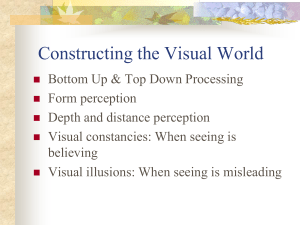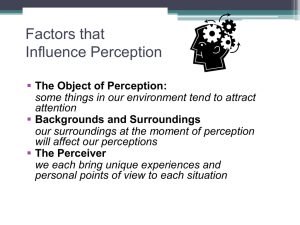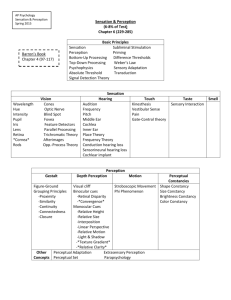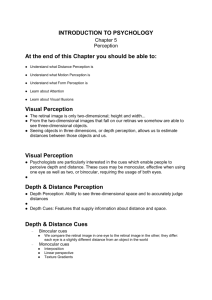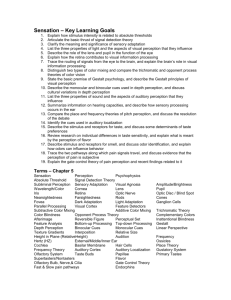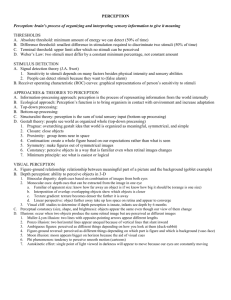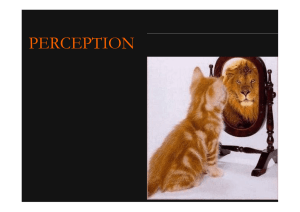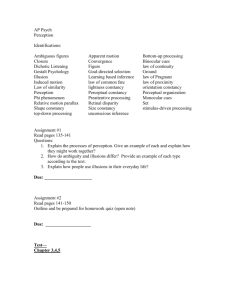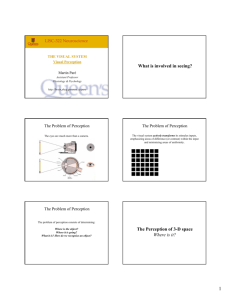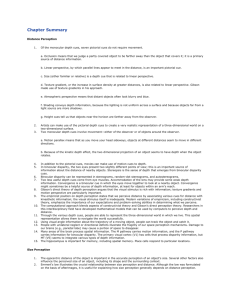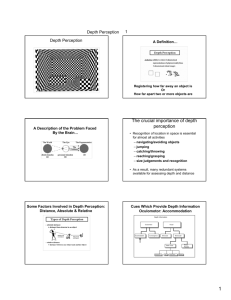Module 9: Perception
advertisement
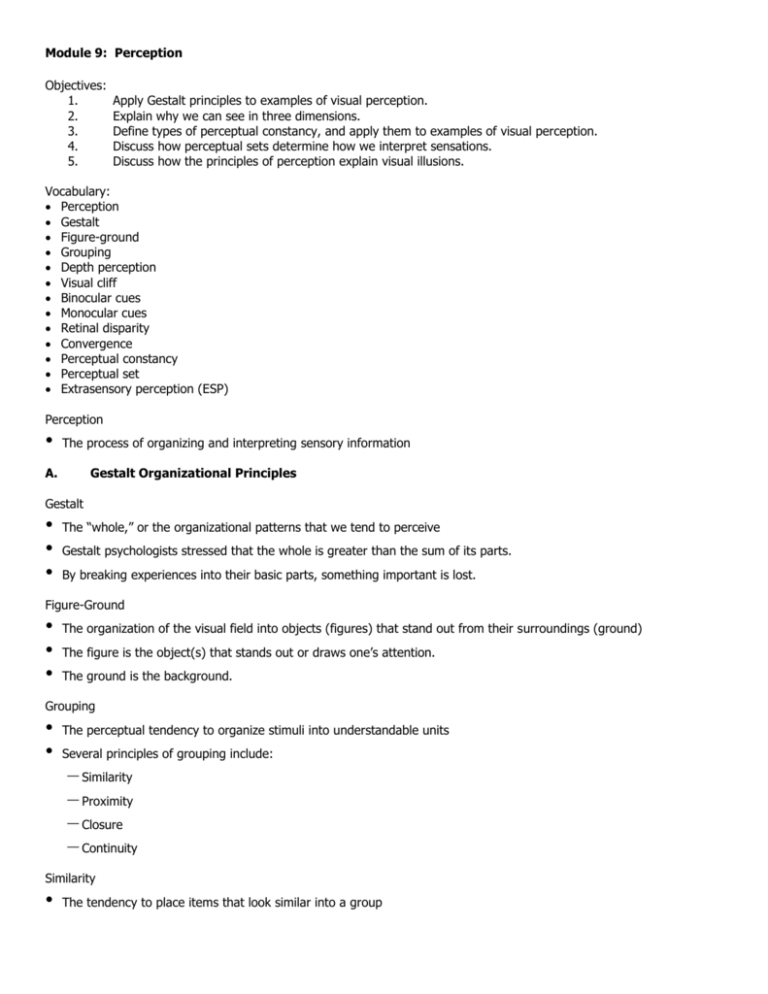
Module 9: Perception Objectives: 1. 2. 3. 4. 5. Apply Gestalt principles to examples of visual perception. Explain why we can see in three dimensions. Define types of perceptual constancy, and apply them to examples of visual perception. Discuss how perceptual sets determine how we interpret sensations. Discuss how the principles of perception explain visual illusions. Vocabulary: Perception Gestalt Figure-ground Grouping Depth perception Visual cliff Binocular cues Monocular cues Retinal disparity Convergence Perceptual constancy Perceptual set Extrasensory perception (ESP) Perception • The process of organizing and interpreting sensory information A. Gestalt Organizational Principles Gestalt • • • The “whole,” or the organizational patterns that we tend to perceive Gestalt psychologists stressed that the whole is greater than the sum of its parts. By breaking experiences into their basic parts, something important is lost. Figure-Ground • • • The organization of the visual field into objects (figures) that stand out from their surroundings (ground) The figure is the object(s) that stands out or draws one’s attention. The ground is the background. Grouping • • The perceptual tendency to organize stimuli into understandable units Several principles of grouping include: – Similarity – Proximity – Closure – Continuity Similarity • The tendency to place items that look similar into a group Proximity • The tendency to place objects that are physically close to each other in a group Closure • The tendency to look at the whole by filling in gaps in a perceptual field Continuity • B. • The tendency to perceive that movement of an object continues once it appears to move in a particular direction Depth Perception The ability to see in three dimensions and judge distance Visual Cliff • • • • A laboratory device for testing depth perception in infants and young animals Infants are reluctant to crawl past the “edge” of the visual cliff Other animals had similar results. Suggests that depth perception, to some extend, is inborn Binocular Cues • Depth cues that require the use of both eyes Retinal Disparity • • A binocular depth cue resulting from slightly different images produced by the retina of the left and the retina of the right eye Is most effective when the item is quite close to the person Convergence • • • A binocular depth cue related to the tension in the eye muscles when the eyes track inward to focus on objects close to the viewer The more tension in the eye muscle, the closer the object is Works best at close distances Monocular Cues • • Depth cues that require the use of only one eye Monocular depth cues include: relative size, relative motion, interposition, relative height, texture gradient, relative clarity, and linear perspective. Relative Size • • Using the perceived size of a familiar object to determine depth The larger the object appears, the closer the object is to the viewer Relative Motion • • • A person who is moving can determine depth by focusing on a distant object. Objects further away than the object of focus will appear to move in the same direction as the subject is moving. Objects closer than the object of focus will appear to move in the opposite direction. Interposition • • Method of determining depth by noting that closer objects partially obstruct the more distant objects Also called “overlap” Relative Height • Method of determining depth by noting that distant objects appear higher in your field of vision than do closer objects Texture Gradient • Method of determining depth by noting that distant objects have a smoother texture than nearby objects Monocular Depth Cues – Relative Clarity • • Method of determining depth by noting that distant objects are less clear than nearby objects Tends to work outdoors Linear Perspective • • C. • • Method of determining depth by noting that parallel lines appear to converge in the distance The lines appears to eventually merge on the horizon. Perceptual Constancy Perceiving the size, shape, and lightness of an object as unchanging, even as the image on the retina of the eye changes The understanding that objects usually remain the same Size Constancy • • • A person’s understanding that as an object moves further or closer to them its actual size stays the same As an object appears to become larger we realize it is getting closer, not bigger. As an object appears to become smaller we realize it is moving farther away, not getting smaller. Shape Constancy • The understanding that an object’s shape remains the same even though the angle of view makes the shape appear changed Light Constancy • D. • • • • E. • • The ability to see an object as having a constant level of lightness no matter how the lighting conditions change Perceptual Set A mental predisposition to perceive something one way and not another Example of top-down processing Influence of the “power of suggestion” (subliminal perception) Guided by schemas: concepts or mental frameworks that organize and interpret information Illusions Misinterpreting sensory stimuli Help researchers understand how sensation and perception normally works

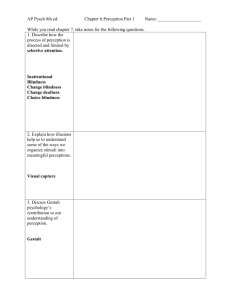

![PERCEPTION powerpoint[1].](http://s3.studylib.net/store/data/009457343_1-6b71423308f582839d1485b3b84f87a3-300x300.png)
